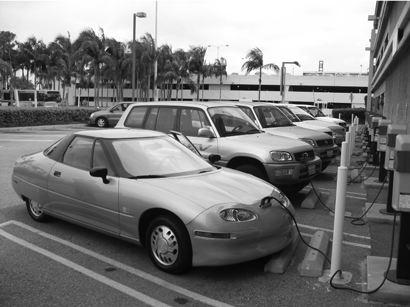The future minus a vision
As its title suggests, “Who Killed the Electric Car?” is a whodunit. Delving into the electric car’s short life as a commodity, it raises a host of other issues, particularly regarding the effectiveness of marketing and the ease of manipulating America’s “free market.” It’s also extremely optimistic. Lurking beneath its eco-outrage is a vision of car culture free from pollution and dependence on foreign oil. “Who Killed the Electric Car?” celebrates the battery-powered vehicles’ speed and sleek design, imagining how they could have finally delivered on the mythic promise always implicit in cars with much fewer negative consequences.
As Phyllis Diller testifies, electric cars were more popular than gas-powered ones 100 years ago, but the latter quickly overtook them. Until 1990, few saw any need to revive them. However, the California Air Resources Board (CARB) then pinpointed car exhaust as the source of California’s severe smog crisis. Touched off by General Motors’ announcement of a prototype electric vehicle, CARB created the Zero Emissions Mandate, which required a gradually increasing percentage of cars sold in California to be emission-free. In 1996, GM launched the EV-1. It needed little maintenance, and while it wasn’t a huge success, its “owners”—the company preferred leasing the autos—were quite taken with it. Six years ago, they were taken off the market, GM’s fleet gathering dust in storage or even being crushed.
“Who Killed the Electric Car?” offers a brief history of the car, interviewing many of its fans, but it builds to a segment in which it examines the guilt of a number of parties in taking it off the market—consumers, politicians, CARB, the oil industry. Not surprisingly, it finds most of them culpable. Despite Paine’s focus on the evils of corporations and government, ordinary consumers do take their share of the blame.
I refer to EV-1 drivers as “fans” deliberately; their passion and devotion recalls the cult audience for “The Matrix” or “Star Wars.” Opinions about the auto industry’s marketing of the EV-1 vary, but all agree that it didn’t work. Some of Paine’s interview subjects skirt conspiracy theory, as the film suggests that GM deliberately did a bad job of advertising them. A bizarre EV-1 commercial shows why they might be right. Austere and arty, it uses imagery invoking the shadows burned onto concrete by the nuclear blast at Hiroshima. Until the car appears, one might think it’s a parody of a trailer for an Alain Resnais or Ingmar Bergman film. Selling speed and sex appeal—the bread and butter of most car ads—are far removed from its agenda.
Much like a ‘60s European art film, the EV-1 had a limited but passionate audience. Perhaps it never would have crossed over to the mainstream, but the American public never got their chance to find out. The auto industry fought the Zero Emissions Mandate, especially once Bush took power and chimed in on their side. Hydrogen cells became his alt-fuel of his choice, but “Who Killed the Electric Car?” heaps scorn on their proponents. According to the film, the technology is about two decades away from being feasible, while electric cars are perfectly viable now.
“Who Killed the Electric Car?” sees a small glimmer of hope in hybrid cars like the Prius and a larger one in tinkerers who’ve converted such cars, expanding their electrical components so that they’re more fuel-efficient. With the rising cost of gas, the market for the electric car might be much larger now than it was in 1996. One of this film’s most valuable aspects is its depiction of how much spin and governmental maneuvering went into selling Americans on SUVs. Paine interviews a number of celebrities who drove EV-1s, including Mel Gibson. While he wasn’t able to talk to Tom Hanks himself, he includes interview footage of the actor touting the cars on David Letterman’s show.
Unfortunately, some of the smugness that often accompanies actors’ political causes creeps into the film. The energy that went into silly stunts like producing a “funeral” for the EV-1 and keeping a 24-hour vigil outside a GM lot could have been better spent on lobbying. “Who Killed the Electric Car?” works better when it sticks to facts.
It remains to be seen whether Americans will ditch their SUVs en masse, but “Who Killed the Electric Car?” predicts a bipartisan coalition of electric car proponents storming the auto industry’s gates. These good vibes are a little forced; I wasn’t surprised to learn that its cheerful coda was added after the film’s Sundance premiere. Nevertheless, “Who Killed the Electric Car?” is a gripping enough story that the unconverted might even get something out of seeing it. Perhaps GM should have put Paine in charge of marketing the electric car—he does a far better job of making them look appealing than they did.
gaycitynews.com


































